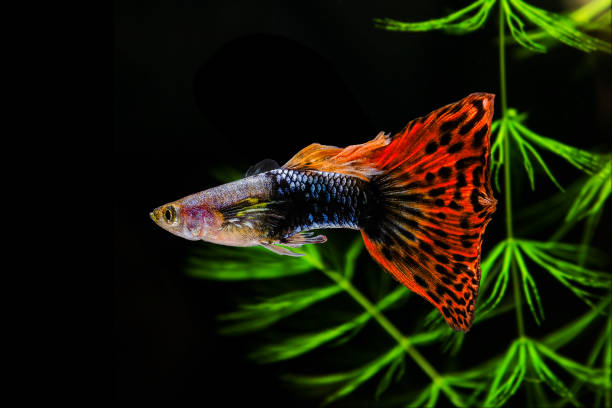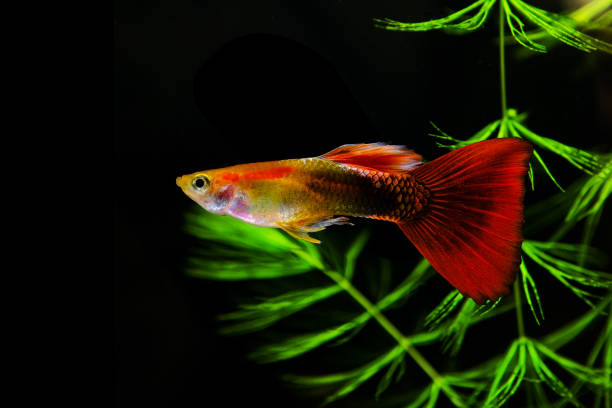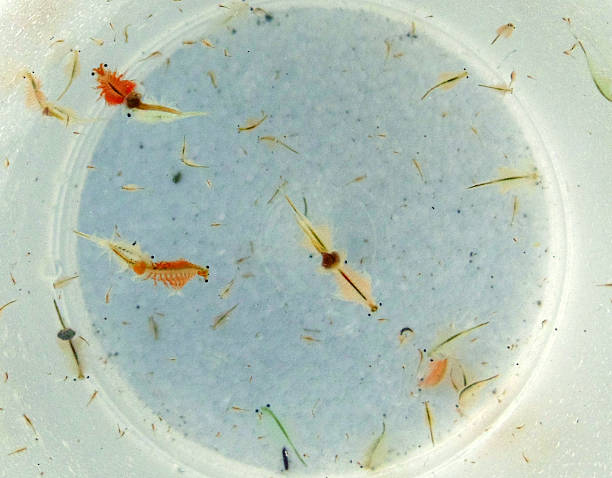Beautify your aquarium with the colorful elegance of the Delta Tail Guppy. Learn the best care tips for pairing this bold-tail variant with other aquatic species.

The Graceful Elegance of Delta Tail Guppies
Welcome back, Aquarium enthusiasts, as I introduce you to the graceful Delta Tail guppy fish, a majestic and captivating aquarium fish renowned for its breathtaking tail and dazzling colors.
This triangle-shaped guppy fish stands out as one of the unique guppy varieties beloved amongst aquarium hobbyists.
The most notable feature of the Delta Tail Guppy is its triangle-shaped tail, which resembles a delta symbol (∆). Its body stretches up to 1-2 inches in length while its tail makes up for the remaining 1-2 inches and showcases a kaleidoscope of colors, including shades of blue, green, purple, and red, making it a prime example of colorful aquarium fish.
The Stunning Physical Traits of Delta Tail Guppies

The Delta Tail Guppy is renowned for its striking physical features, from its signature broad, triangular tail to its small body and contrasting vibrant guppy colors.
This broad-tailed guppy has a tail-fin, which is usually much wider than other guppy species, giving it a unique appearance that dominates every tank despite its small size. Besides its fancy tail, this species has other.
Its other distinctive guppy features include the variety of colors on its skin, ranging from mosaic patterns to spots, swirls, stripes, solid tones, and dual tones. These color varieties make each guppy a one-of-a-kind masterpiece.
Now that you’ve seen a hint of the Delta Tail Guppy’s appearance, here’s how you can care for them:
Caring for Delta Tail Guppies: Essential Guidelines
Delta Tail Guppy Care may be quite tricky to some, but if you follow this guide, you’ve got no issues:
Water
Maintaining the best water quality for guppies is the smartest hack to keeping healthy guppies. Keep temperature between 72-82°F (22-28°C) and pH at 7.0-8.5. Ensure water flow is gentle and hardness is between 5-20 dGH.
Tank Maintenance Tips
Perform regular tank maintenance and sanitation to protect your pets from diseases and environmental illnesses. Change about 25-50% of the tank’s water weekly while closely monitoring water quality and adjusting parameters.
Other essential guppy care tips include building a peaceful community tank by pairing your guppies with mild-mannered species that’ll complement their temperament, maintaining ample space for swimming, and quarantining new guppies before introducing them to the tank.
Designing the Perfect Tank for Delta Tail Guppies
Are you ready to give your Delta Tail Guppy the perfect tank setup? Every detail is important, from the tank’s size to the setup, decor, and lighting. So, pay attention to these tips!
Tank Size
When creating a guppy habitat, ensure you use a tank that is big enough to accommodate the fish from its body to its tail. Your tank size should be a minimum of 20-30 gallons of water.
Tank setup
Your ideal tank environment MUST have a filtration system strong enough to clean it but also slow enough not to suck in your small fish. Use a single filter for 10 to 50 gallons of water and double the canister for larger gallons.
Once you’ve set up the right water parameters and filtration system, it’s time to decorate your tank.
Decor Tips
Your aquarium decor should mimic their natural habitat, which is the South American brackish waters. They should ideally have enough hiding spaces so you can use live plants with soft leaves, such as Java Moss, to create them.
Also, rocks, driftwood, and other sand should be added to create a hyperrealistic habitat.
Feeding Delta Tail Guppies: Nutritional Best Practices

Dietary Requirements
The Delta Tail Guppy diet must have all the classes of food in live form and plant matter. Feed your pets high-quality commercial flake or pellet food formulated for guppies as the main staple, and supplement it with live or frozen foods.
Add vegetable-based foods to boost their digestion and supplement their diet for color enhancement. Consider foods high in beta-carotene, astaxanthin, and chlorophyll, depending on the color of your fish.
You can also add commercially made nutritious guppy food that supports their vibrant colors, healthy tail growth, and overall well-being to their diet if you don’t want to meal-prep live foods.
For more on feeding your aquatic pets check out The Ultimate Guide to Fish Food: Pros and Cons & Best Choices!
Feeding Schedule
Feed twice/thrice daily and only as much as they can consume within 2 minutes. You are not helping or pampering your fish if you continually overfeed them! Instead, you risk giving them obesity or constipation from overfeeding.
The Delta Tail guppy feeding best practices combine proper feeding frequencies with the proper diet.
Protecting Your Delta Tail Guppies: Health and Disease Prevention
Some of the common health problems your guppy may face include regular fish illnesses like fin rot and ich, but they’re also prone to special ailments based on their physical traits. This guide shows you some of the diseases and provides prevention, early detection, and treatment tips to keep you on top of the situation.
Fin Rot
Prevention: maintain optimal tank and water conditions (follow the guide I’ve provided earlier).
Early signs: Frayed or ragged fins, discoloration or darkening of fins, stiff/brittle fins, and lethargic behavior of fish. Check for secondary infections like fungus or bacteria.
Treatment: Isolate affected guppies immediately, perform better water hygiene, treat with antibiotics or antifungal medications specifically designed for aquariums, and nip affected fins with sterile scissors.
Tail damage
Prevention: Maintain optimal water quality and tank conditions.
Early Signs: Torn or frayed tail fins, Split or forked tail fins, Discoloration of tail fins, erratic swimming pattern.
Treatment: Isolate affected guppies, observe better water and tank hygiene, treat with antibiotics or antifungal medications specifically designed for aquariums, and trim affected tail fins with sterile scissors to prevent further damage.
Gill disease
Prevention: Maintain optimal water parameters and tank conditions and quarantine new fish before adding them to the tank.
Early Signs: Labored breathing, Lethargic behavior, Loss of appetite, and Visible signs of gill damage or discoloration.
Treatment: Isolate affected guppies and sanitize the water. Treat with antibiotics or antiparasitic medications and increase water oxygenation through aeration.
By following these Delta Tail Guppy health tips, you can help prevent various diseases in your delta guppy fish and ensure early detection and effective treatment if it does occur.
Treating guppies may be tricky, so ensure you always check for secondary diseases and take steps to prevent guppy diseases.
Mastering the Art of Breeding Delta Tail Guppies

Delta Tail Guppies Fry
Breeding Delta Tail Guppies is an art that requires careful planning and execution. Here’s a rundown of what to look out for when breeding this fish.
Selecting Breeding Pairs
When selecting breeding pairs, look out for healthy, vibrant fish with desired tail characteristics and complementary traits.
This video has been very helpful in identifying the sex of Guppies, I highly recommend it:
Optimal Breeding Conditions
Set up a separate breeding tank of 5-10 gallons with optimal water parameters. Ensure the tank has sufficient hiding places and visual barriers. Use a sponge filter or gentle air stone to minimize water disturbance and maintain water purity.
Breeding Process
Introduce the breeding pair to the breeding tank and watch closely, especially in the morning for spawning. After spawning, remove the adult guppies and monitor fry development.
Caring for the Fry
Still maintaining optimal water quality, provide infusoria or commercial fry food. Monitor for disturbances such as disease or stress.
Raising Healthy Fry
Gradually transition fry to larger tanks (10-20 gallons) while maintaining excellent water parameters. Select and separate fry with desired traits for future breeding. Raising a healthy fry is doable if you maintain optimal water parameters and pay close attention to the fish reproduction cycle.
By following these guppy reproduction tips, you are sure to preserve the unique tail characteristics of the Delta Tail Guppies you breed!
Delta Tail Guppy Behavior is peaceful and calm in nature. They are active swimmers but can be quite timid. The males are usually territorial and fin-nippy, while the females are more demure, making them a positive addition to a peaceful aquarium setup
Your guppy tank mates are typically gentle fish. Avoid fin-nipping/eating aggressive fish like Tiger Barbs, Clown Loaches, cichlids, and Angelfish. Suitable tank mates include Harlequin Rasboras and Corydoras Catfish.
Before you set up your community tank, do proper research on the community tank compatibility of your desired fish, and you’re sure to enjoy the experience.
Conclusion
Here’s a Delta Tail Guppy care summary to round up our review for today.
- Ensure you have the right setup before adding guppies to your tank.
- Inspect your pets daily for signs of health distress and stress.
- Pair your fish with only compatible varieties to prevent aggression or predation.
They’re an ideal variety if you’re worried about aquarium beauty enhancement using a single species. To keep them thriving, follow the guppy care insights provided in this article and enjoy the beautiful array of their vibrant colors and majestic tails.


